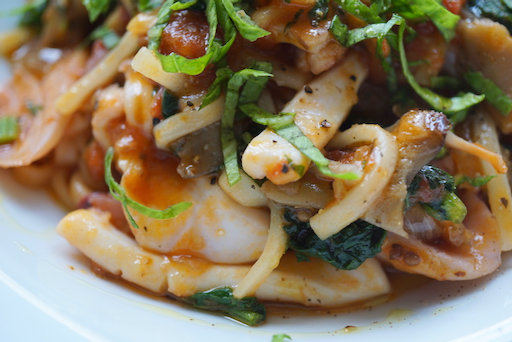We used to get a whole fresh Spanish mackerel at Whole foods, but it has not been available for a long time. Since we started buying groceries from the Korean grocery store HMart through Instacart, we have found they have more variety of whole fresh fish available. We got whole Spanish mackerel from them a few times. This time, however, mackerel was not available but bluefish was. We have used bluefish* in place of Spanish mackerel in the past and decided to go with it. I am not sure how I ordered it (by weight or by the numbers) but I ended up with two rather large bluefish not cleaned at all. So, I had to scale, gut, remove head and make filets. It was a bit of work but the fish was really fresh. As before, I made bluefish simmered in miso sauce ブルーフィシュの味噌煮 from the filets and "tsumire" fish balls soup つみれ汁 from the fish meat scraped off the bones. I set the fish ball soup and miso simmered fish aside for another meal. The remaining filets, I salted and grilled. We happened to have matsutake 松茸 from Oregon mushroom and matsutake rice 松茸ご飯 rice leftover from dinner the previous night. So I made matsutake soup 松茸のお吸い物, warmed up the rice and served with the bluefish for our lunch on Sunday.
* I am not sure of its Japanese name but it appears to be "Oki-suzuki" オキスズキ. I have not seen or eaten it while I lived in Japan.
I first salted the fillet and let it sit in the refrigerator for a few hours. I cooked the bluefish filet with a small amount of olive oil in a frying pan on low flame with skin side down until the skin got brown (6-7 minutes, I also applied decorative cuts on the skin to prevent the skin breaking during the cooking). I cooked 80% on the skin side, flipped it and completed the cooking. I served this with pickled myoga 冥加の甘酢漬け, salt picked cucumber and nappa cabbage きゅうりと白菜の浅漬け and thinly sliced cucumber dressed in sushi vinegar 胡瓜の酢の物. Since the fish was well-salted, we did not need additional sauce such as soy sauce for this.
For the matsutake soup 松茸のお吸い物, I made bonito "dashi" カツオの出汁 from a dash pack seasoned with mirin and light colored soy sauce and salt, added thinly sliced matsutake, silken tofu, "kyoubu" 京麩 decorative gluten cake (dried, hydrate before adding to the soup), freeze dried "mitsuba" 三つ葉 and yuzu zest ゆず (frozen).
The bluefish prepared this way was very good. The flesh was pleasingly oily, soft and had a nice flavor. The skin did not get crispy but stayed soft. It may have been a bit strong tasting fish to accompany the delicate matsutake but we really enjoyed this lunch.










































